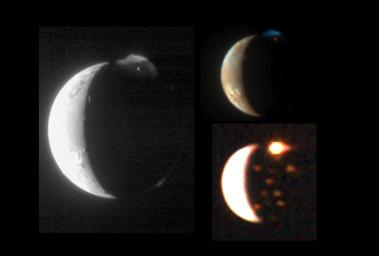- Original Caption Released with Image:
-
This montage demonstrates New Horizons' ability to observe the same target in complementary ways using its diverse suite of instruments. Previously released views taken at visible and slightly longer infrared wavelengths with the Long Range Reconnaissance Imager (LORRI), New Horizons' high-resolution black-and-white camera, and the Multispectral Visible Imaging Camera (MVIC), its color camera, are here compared with a nearly simultaneous view from the Linear Etalon Imaging Spectral Array (LEISA), which observes its targets in more than 200 separate wavelengths of infrared light. This color LEISA view of Io (bottom right) combines three wavelength ranges, centered at 1.80, 2.04, and 2.31 micrometers. The LORRI image (left) shows fine details on Io's sunlit crescent and in the partially sunlit plume from the Tvashtar volcano, and reveals the bright nighttime glow of the hot lavas at the source of the Tvashtar plume. The MVIC image (top right) shows the contrasting colors of the red lava and blue plume at Tvashtar, and the sulfur and sulfur dioxide deposits on Io's sunlit surface. The LEISA image shows that the glow of the Tvashtar volcano is even more intense at infrared wavelengths and reveals the infrared glow of at least 10 fainter volcanic hot spots on the moon's nightside. The brightest of these, Amirani/Maui, which is visible to the lower right of Tvashtar, is less than 4% as bright as Tvashtar. All of these are long-lived hot spots that have been observed previously by the Galileo orbiter. Further analysis of the LEISA data will provide information on the volcanoes' temperatures, and data on the sunlit crescent of Io will reveal details of Io's surface composition.The LORRI, MVIC and LEISA images were taken March 1, 2007, at 00:35, 00:25 and 00:31 Universal Time, respectively, from a range of 2.3 million kilometers (1.4 million miles). The images are centered at Io coordinates 4 degrees south, 164 degrees west.
- Image Credit:
-
NASA/Johns Hopkins University Applied Physics Laboratory/Southwest
Research Institute
Image Addition Date: -
2007-05-01
|

 Planetary Data System
Planetary Data System












